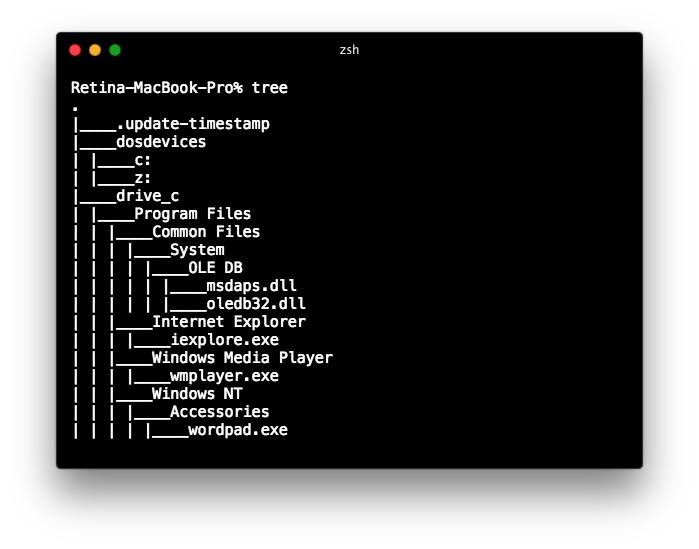

- #Os x open terminal at folder how to#
- #Os x open terminal at folder mac os x#
- #Os x open terminal at folder code#
- #Os x open terminal at folder mac#
I’m too lazy to provide a new screen snapshot today, but here in 2023, my OpenTerminalInFinderDir.scpt script appears at the bottom of a similar-looking menu on the menubar.
#Os x open terminal at folder mac#
When you combine this with enabling AppleScript in the Mac menubar (see the link below), the result looks something like this: Here in April, 2023, I named this file OpenTerminalInFinderDir.scpt, and put it in either /Library/Scripts/AlsScripts or ~/Library/Scripts/AlsScripts. When I have a Mac Finder window in the foreground and run this script from the AppleScript menu on the macOS menubar, it opens a new Mac Terminal window, and automatically places me in the same directory as the current Finder folder. Set thePath to (quoted form of POSIX path of (target of myWin as alias))
#Os x open terminal at folder code#
Fortunately the script code is relatively readable. If you want to open a new tab in an open Terminal window, go. The decimal is the Unix way of referring to the current directory. Select the folder, right-click on it, and go to Services > New Terminal at Folder to open a new Terminal window to the selected folder. Yes, that is a decimal after the open command. I couldn’t find any other way to do this, so I finally wrote an AppleScript script to do it. To open a Finder window in the current directory of your Mac Terminal just issue this Mac open command: open. AppleScript code to open a Terminal in the current Finder folderįor a while I have wanted to be able to open a Mac Terminal window in the same directory as the Mac Finder folder that I’m currently looking at. Tick the box for 'New Terminal at Folder' (there should be an option similar to that if you use an alternative terminal like iTerm2). In the services category scroll down to 'Files and Folders'.
#Os x open terminal at folder how to#
Ls: The "ls" command, by itself, displays the contents of the cwd.Apple/macOS Terminal/Finder tip: This tutorial shows how to open a Mac Terminal window in the current Finder folder by using AppleScript. 1 Answer Sorted by: 5 Go to your keyboard settings>shortcuts. To actually put all this path knowledge to use, you'll need the Terminal commands for displaying and changing files. Here’s an example of using nano to open a new file named nf. If you want to create a new file, type the editor name, followed by a space and the pathname of the file. How to display and move between files in Terminal In the Terminal app on your Mac, invoke a command-line editor by typing the name of the editor, followed by a space and then the name of the file you want to open. When you first launch Terminal, you're starting in the current working directory of /Users/ myusername/ (also known as your User folder). In the Terminal app on your Mac, invoke a command-line editor by typing the name of the editor, followed by a space and then the name of the file you want to open. You can then get to your Utilities folder by typing "./Utilities/" rather than "/Applications/Utilities". For instance, if you go to the "/Applications/" folder in Terminal, that's your current working directory ( cwd). Relative paths are defined based on where you've already navigated to, and represented by "./". Optionally, you can also add keyboard combination, which we recommend. Just paste in modal window your path and press Enter It will throw an error if the folder does not exist, or the path points to a file. To add Terminal shortcuts to the Services menu, click on the Services category, scroll down to Files and Folders and enable New Terminal at Folder and if desired, New Terminal Tab at Folder.

So if you wanted to make a path to your Applications folder, you would write "/Applications/". Press + + G If you want to do it from Dock - press and hold left mouse on Finder icon and choose Go to Folder. An absolute path starts at the root level of your hard drive, and is displayed as "/".
#Os x open terminal at folder mac os x#
Paths take two forms: absolute paths and relative paths. 17 Answers Sorted by: 187 As of Mac OS X Lion 10.7, Terminal provides Services for opening a new terminal window or tab at the selected folder in Finder. Paths look similar in some ways to website sub-directories, and follow the structure of your folders. To do so, you build something called a path. You can use Terminal to get direct access to your files without using the Finder. When writing commands and paths in Terminal, almost everything is case sensitive: This means that you need to remember to properly capitalize "Dock" when referring to the Dock, or OS X won't understand your command. Unless you're executing a command that requires the display of text in Terminal, you won't have any indicator that what you've done has been successful you'll just get a new line with your user name on it once the command is finished processing.


 0 kommentar(er)
0 kommentar(er)
